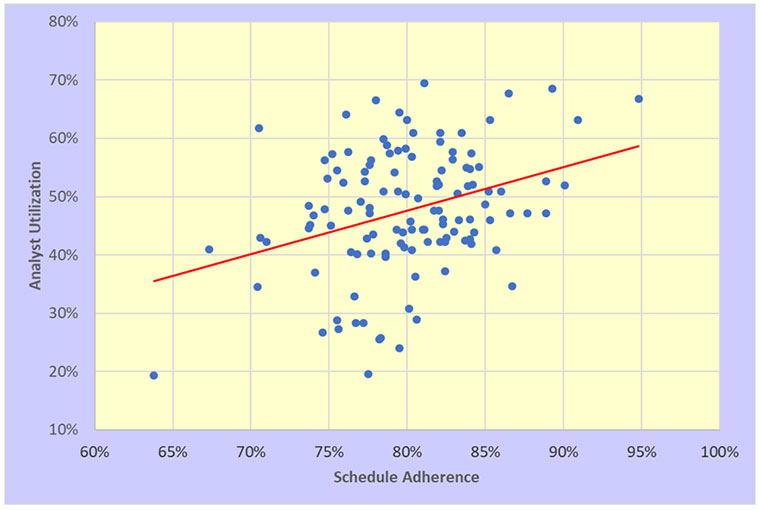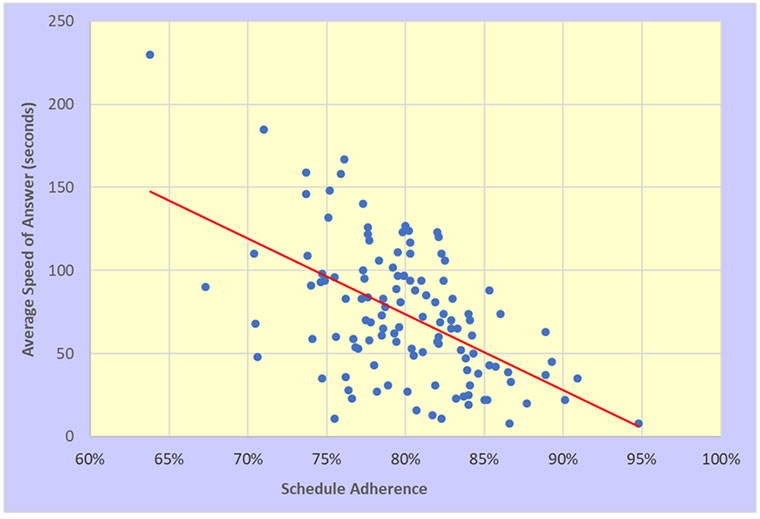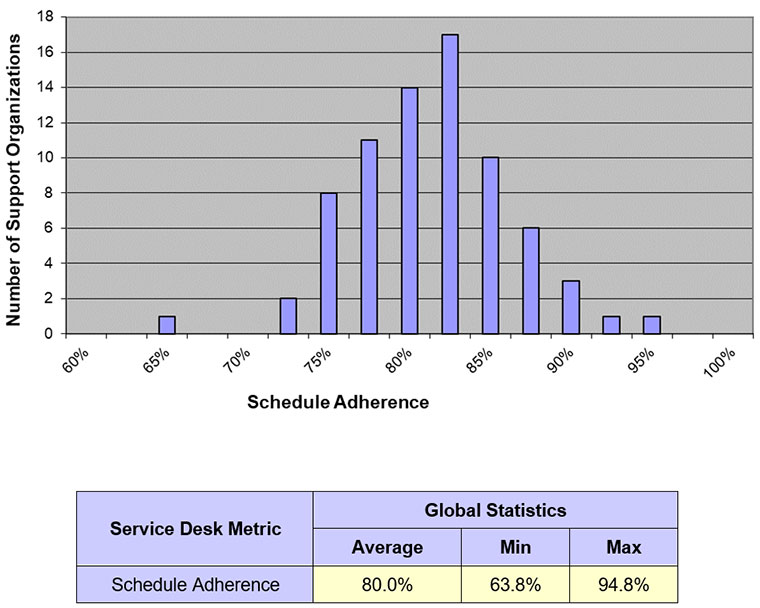Date Published February 21, 2020 - Last Updated September 2, 2020
Each month, I highlight one Key Performance Indicator (KPI) for service and support. I define the KPI, provide recent benchmarking data for the metric, and discuss key correlations and cause-and-effect relationships for the metric. The purpose of the column is to familiarize you with the KPIs that really matter to your organization and to provide you with actionable insight on how to leverage these KPIs to improve your performance! This month, I look at schedule adherence.
Schedule adherence is a service desk metric that measures whether analysts are in their seats ready to accept calls, chats, emails, or web tickets as scheduled. That is, it measures how well a service desk’s analysts are “adhering” to the work schedule. Schedule adherence is equal to the actual time that an analyst is logged in to the ACD or ITSM system ready to accept customer contacts, divided by the total time the analyst is scheduled to be available to accept customer contacts.
Analyst Schedule Adherence = (hours that an analyst is actually available for or delivering customer service ÷ hours that an analyst is scheduled to be available).
As an example, let’s assume that an analyst is scheduled to work the chat line from 8:00 AM to 11:30 AM in the morning, and from 12:30 PM until 4:30 PM in the afternoon. Let’s further assume that the analyst logs into the chat system at 8:15 AM, and logs out for lunch at 11:15 AM, and for the afternoon shift logs into the chat system at 12:30 PM and logs out at 4:00 PM. The analyst was scheduled to work 3.5 hours in the morning, and 4.0 hours in the afternoon. However, the analyst worked only 3 hours in the morning and 3.5 hours in the afternoon. Using the formula above, hours worked = 6.5 (3 hours in the morning + 3.5 hours in the afternoon), and hours scheduled = 7.5 (3.5 hours in the morning + 4 hours in the afternoon). The calculated schedule adherence for this analyst on this particular day is therefore 86.7% (6.5 hours worked ÷ 7.5 hours scheduled).
The metric can be measured by analyst, or for the entire service desk by averaging the schedule adherence of the individual analysts. Most ITSM and/or ACD systems will automatically calculate schedule adherence by analyst or for the entire service desk on a daily, weekly, and monthly basis.
Why It’s Important
Effective analyst scheduling is critical to achieving a service desk’s service-level goals and maximizing analyst utilization. But a work schedule, no matter how well constructed, is only as good as the adherence to the schedule. It is therefore important for analysts to adhere to the schedule as closely as possible to ensure that productivity and service-level goals are met.
Effective analyst scheduling is critical to achieving a service desk’s service-level goals.

Schedule adherence is strongly correlated with the following metrics:
- Analyst utilization
- Inbound contacts per analyst per month
- Analyst occupancy
- Average speed of answer
- % of contacts answered within X seconds
Two of these correlations are illustrated graphically in the figures below.


Benchmark Data for Schedule Adherence
The power of schedule adherence is underrated by many service desks. As a result, only about 40% of service desks actively track this metric. This is unfortunate since good schedule adherence can dramatically improve service levels and analyst utilization and reduce cost per ticket.
As shown in the next figure, the average schedule adherence for service desks worldwide is about 80%, but the metric varies dramatically, from a low of 63.8% to a high of 94.8%. As a general rule-of-thumb, a good target for schedule adherence is 90%.

Improving Schedule Adherence
Poor schedule adherence can be the result of several factors. Weak discipline in the workplace is one of the most common causes of low schedule adherence. If it becomes culturally acceptable to arrive late to work, return late from lunch or breaks, or leave work early, schedule adherence will suffer. Likewise, unplanned absenteeism has a negative impact on schedule adherence. And not having a schedule adherence target—by analyst and for the service desk overall—can also result in low schedule adherence.
The single best thing you can do to drive better schedule adherence is to hold each analyst accountable for their adherence target. If, for example, the analyst schedule adherence target is 90%, any analyst who falls below 85% for the month should be coached on ways to improve their adherence. Moreover, schedule adherence should be included in every analyst’s balanced scorecard. Over time, a well-publicized adherence target combined with individual coaching sessions for low performers will have the effect of producing an “adherence culture,” where the norm becomes good schedule adherence and it is culturally unacceptable to fall short of one’s adherence target.
Finally, there’s a common notion that schedule adherence on a small service desk is unimportant. Nothing could be further from the truth. The Erlang C distribution—the probability distribution that defines the rate at which contacts arrive at a service desk—is particularly unforgiving to smaller service desks. All it takes is a few calls in queue before ASA and service levels blow up! The best way to combat this is to ensure that every analyst is adhering to the schedule, particularly during periods of heavy inbound volume.
Please join me for next month’s Metric of the Month: Customer Effort, a customer experience metric that is growing in popularity in the IT service and support community.
Jeff will be teaching a two-day workshop, Succeeding with Metrics, at SupportWorld Live!
Join us!
Jeff Rumburg is the winner of the 2014 Ron Muns Lifetime Achievement Award, and was named to HDI’s Top 25 Thought Leaders list for 2018. As co-founder and CEO of MetricNet, Jeff has been retained as an IT service and support expert by some of the world’s largest corporations, including American Express, Hewlett Packard, Coca-Cola, and Sony. He was formerly CEO of the Verity Group and Vice President of Gartner. Jeff received his MBA from Harvard University and his MS in Operations Research from Stanford University. Contact Jeff at
[email protected]
. Follow MetricNet on Twitter @MetricNet.